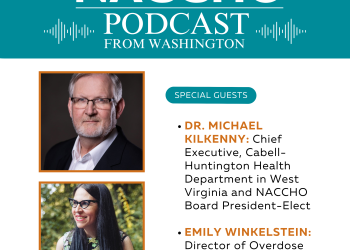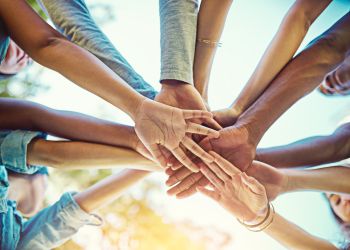By Kimberly Aguillard, NACCHO Health and Disability Fellow
Loneliness and social isolation are growing public health epidemics in America. Loneliness is the subjective feeling of being isolated, left out, and lacking quality social connections. Social isolation refers to a quantitative count of social networks and relationships. People can be surrounded by social acquaintances (e.g., coworkers, classmates, neighbors), while still feeling alone and lonely.
Who Experiences Loneliness?
According to prominent surveys, between 22% (The Economist and Kaiser Family Foundation survey) and 61% (The Signa 2020 Loneliness Index) of adults in the United States indicate they feel lonely, lack meaningful relationships, or feel excluded or socially isolated. Loneliness rates vary by age and generation. Rates of loneliness resemble a U-shaped arc: Subjective loneliness is high in adolescence and young adulthood, declines through middle age, and increases again in old age. While there is more awareness of widespread loneliness among seniors, the Signa study reported, “Generation Z (adults ages 18-22) is the loneliest generation.”
Loneliness is common among people who experience major life events, such as divorce, illness, death of a loved one, or losing a job. Life transitions, like retirement or moving to college, also may cause loneliness. Finally, barriers in the environment, such as transportation problems and accessibility obstacles (either structural or communication-related) increase the likelihood of loneliness and social isolation. Loneliness is more common among individuals with low incomes and individuals with physical health problems.
According to the Behavior Risk Factors Surveillance Survey (BRFSS), 1 in 4 Americans has a disability. People with disabilities represent a cross-section of society; however, as a group they are more likely to experience lower socioeconomic status, unemployment or underemployment, social and geographic isolation, and barriers accessing community opportunities. Therefore, interventions to address loneliness must include thoughtful and purposeful strategies to include the disability community.
What are the Health Consequences of Loneliness?
Research has revealed that loneliness is more than just a feeling; it has enormous health consequences, frequently contributing to worsening chronic disease burden, depression and anxiety, and functional and cognitive decline. Social isolation leads to changes on a cellular level that can create chronic inflammation, making lonely people more susceptible to conditions such as heart disease, stroke, and Alzheimer’s disease. A 2015 meta-analysis, which included 70 studies of 3.4 million participants, found that lonely individuals had a 26% higher risk of premature death—or 32% if they lived alone. Loneliness kills. It poses a greater threat to health than obesity, and its life-shortening effects are comparable to smoking 15 cigarettes a day.
What Can Help?
Social connection is the key to protecting against the negative consequences of loneliness. The Harvard Study of Adult Development has followed participants over their life course (80 years), and found that people with stronger social connections were the healthiest and happiest. Another compelling study found that loneliness “spreads through a contagious process” in communities.
As people became lonelier, they drifted to the margins of social networks, creating a kind of domino effect. Therefore, to be effective, interventions need to account for complex layers contributing to loneliness, as well as the unique circumstances that shape each individual’s resources and needs. Contexts to consider include individuals with lower health literacy, non-English speakers, people living in rural areas, people with low incomes, and people with limited or no transportation options.
Local Solutions
Here are some resources and ideas to help local communities identify ways to support social connectedness and mitigate effects of loneliness:
- Partner with organizations already serving different residents (such as older adults or individuals with disabilities) that have established the cultural credibility and networks needed to jump-start services and programming. One excellent example is Meals on Wheels America.
- Mental Health America suggests a variety of options for combating loneliness. Outdoor activities and experiencing nature support emotional wellbeing and decrease depression and anxiety. Social groups centered around activities, like walking clubs, exercise classes and community choirs, for example, can make it easier to engage with peers.
- The National Institutes of Health promotes the benefits of volunteering. Helping others is one of the best ways to break the cycle of loneliness. It also encourages gratitude, a habit strongly linked to happiness. It is important to make volunteer experiences inclusive; people with disabilities can and do volunteer, but they may encounter barriers that prevent some formal volunteer opportunities.
- The National Association of Area Agencies on Aging and the AARP Foundation offer a fact sheet highlighting risk factors for loneliness and social isolation and suggestions for strengthening social connections (including volunteerism and community engagement). There is also a tool that sends text message reminders to keep in touch with friends.
- A ‘chat bench’ is a concept that originated in London. Any community could try this strategy because it is virtually cost-free! The police department tagged benches in parks with a sign reading, “The ‘Happy to chat’ bench. Sit here if you don’t mind someone stopping to say hello.” The Washington Post wrote about this simple and effective way to break down the invisible walls that separate people.
- A startup called Papa has partnered with several health insurers to connect seniors with college-age people who sign up to help out with transportation, chores, or just check in and chat. This program addresses the U-shaped prevalence of loneliness by engaging the two age-ranges most at risk to experience loneliness. Another innovative program, Judson Manor, a retirement community in Cleveland, OH, creates intergenerational living arrangements where several graduate students live amid the senior residents. Room and board for the students is free, and in exchange, they perform concerts, share art lessons or technology tips, and often eat together.
Every connection matters. What are some ways your local health department can facilitate more social connectedness among all members of your community?



